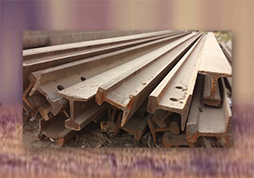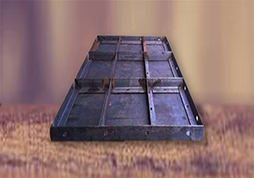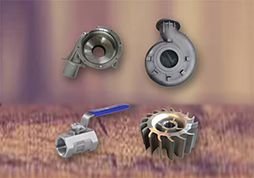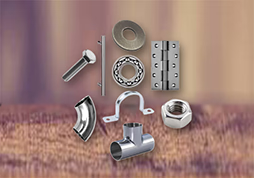An angle is an L-shaped cross-section commonly used in construction. It usually forms a 90-degree angle with equal sides. The representation of an angle is based on its width (W) and thickness (T). Steel angle bars are hot-rolled with inside radius corners, making them suitable for structural applications, fabrication, and repairs. They can also come with a galvanized finish. Different sizes and grades are available, each with a unique chemical composition.
Steel angles are produced in various locations like Mandi Gobindgarh, Raipur, Ahmedabad, Ghaziabad, Jaipur, Jodhpur, and more. Some variations include slotted angles and Z angles.
Channels, commonly known as C-channels due to their C-like shape, are represented by their web height and flange width. They primarily bear horizontal gravitational forces and find applications in various engineering industries, such as bus body construction and EOT cranes. Also called Parallel Flange Channel (PFC), these structural channels are mainly used in building construction and civil engineering. They come in different sizes and grades, each with a specific chemical composition.
Manufactured in locations like Mandi Gobindgarh, Raipur, and Ghaziabad, channels have diverse uses:
HR Coils are like big rolls of steel that are made in special mills to meet high-quality standards. They use pure materials like iron ore to create these coils, and the whole manufacturing process follows strict international standards. The surface of HR Coils is smooth and even because they use top-quality raw materials and advanced manufacturing techniques.
These coils have a consistent thickness and are made in a way that limits variations in width. HR Coils go through a technically advanced process, ensuring that the final product meets all the standards for physical properties.
Hot Rolled (HR) Coils are excellent steel coils used in industries. They are made by rolling steel at very high temperatures, making them more flexible and easier to shape compared to cold-rolled sheets. You can recognize them by their grey finish and rounded corners. These coils are suitable for tasks like machining and metalworking that don't require extremely precise dimensions.
Flats are thin strips of mild steel or higher-grade materials with a specified thickness, widely utilized across various industries. They find applications in industrial gratings, fabrication projects, and even domestic use such as window grills. The representation of flats is based on their width (W) and thickness (T), available in different sizes and grades with distinct chemical compositions. Major manufacturing centers include Mandi Gobindgarh, Raipur, Ahmedabad, Ghaziabad, Jaipur, Jodhpur, and more.
Uses of FLAT:
A Beam Joist, also known as I-beam, is a linear structure designed to carry loads primarily in bending. It offers cost-effective solutions for floor and roof systems, especially in applications that require long clear spans and lighter weight systems. I-beams are constructed with horizontal flanges and a vertical element known as the "web," typically made of structural steel, widely used in construction and civil engineering. They come in various sizes and grades with different chemical compositions, and are predominantly manufactured in Mandi Gobindgarh and Raipur.
Uses of JOIST/GIRDER:
Hot Rolled Steel Plates (HR plates): These plates are crafted from high-quality rolling slabs using a specialized hot rolling process conducted at elevated temperatures. This method, performed above the steel's normal recrystallization temperature, ensures greater formability. Hot rolled sheets can be easily cut into various shapes and sizes, making them versatile for use in industries such as automobile, construction, transportation, and more.
Hot Rolled Steel Sheets (HR Sheets): These industrial-grade flat steel sheets are rectangular in shape, manufactured at high temperatures on rolling mills from steel slabs or billets. They serve as a crucial raw material in manufacturing and infrastructure due to their distinct mechanical properties and versatility. The hot rolling process provides these sheets with a rough texture and a slightly bluish-grey finish.
Metal rolls are used in rolling mills to shape metal into specific sizes. These rolls come in pairs and are part of rolling mills that quickly turn metal, usually steel, into things like structural steel (I-beams, angle stock, channel stock), bar stock, and rails. Steel mills often have rolling mill divisions that transform semi-finished casting products into finished items.
Rolling is a metal-shaping process where metal stock goes through rolls to reduce thickness, make it even, or give it specific properties. The process is classified based on the metal's temperature. If it's hot, it's called hot rolling. If it's cold, it's cold rolling.
These rolls come in different sizes and grades like Adamite, Super Adamite, graphite, alloy steel, hiten alloy, SG, Accicular SG, Chill, etc.
These rolls are mostly made in Malerkotla and Mandi Gobindgarh.
Patra is produced through a non-standardized "Patra Mill" that lacks provisions for enhancing product quality. The manufacturing process involves casting ingots from low-quality raw materials or other commercially subpar materials. Due to the non-standardized rolling process and the use of low-quality raw materials, controlling the chemical composition of Pattra is challenging. The surface finish of Patra is coarse due to the rough rolling process and the use of inferior raw materials. The thickness and consistency of Patra may vary, as the manufacturing process does not ensure uniformity. Additionally, there is a high degree of variation in the width of Patra. The physical properties of Patra are not consistent throughout the product, as quality control is not feasible in its manufacturing process.
Metal profile sheets are like big metal pieces that can cover the outside of buildings. People often use them for sheds and different types of buildings like those for farming, industry, stores, and fun activities.
These sheets come in different shapes like wavy or bumpy, and they're made to fit different styles of roofs and walls, such as wavy, triangular, or rounded shapes.
Railways use a lot of steel products, and from time to time, they auction off their old materials as scrap. People from Loha Mandi (steel markets) take part in these auctions, placing their highest bids based on their capabilities. The highest bidder then buys the scrap, which includes things like railway lines, sleepers, keys, fish plates, coaches, and more.
Mera Loha has a big network of these bidders who actively participate in railway scrap auctions. They buy the scrap and supply it to different industries, ensuring a continuous flow of both scrap and finished materials made from the recycled scrap. This helps keep the steel markets running smoothly.

Pipes are hollow iron tubes that come in various shapes like Round, Square, Rectangle, Pattams, and Railings. There are two main types: Seamless Pipes, formed from solid steel through heating and casting, and Welded Pipes, made by cold forming flat strips into the desired shape and then welding.
These tubes find application in manufacturing railings; flex boards, windows, door frames, agricultural equipment, machinery stands, and ancillaries. Pipes are available in different sizes, with options for light and heavy weights. Mandi Gobindgarh is a significant hub for pipe manufacturing.
Round bars come in two main types: Plain Round Bars and TMT Bars. Plain Round Bars find applications in forging, bright bar, auto-ancillary, and engineering industries, being used for various components like bolts, pins, rollers, and more. They are available in different sizes and grades.
Bars, on the other hand, are primarily used in construction for buildings, roads, pillars, and bridges. These bars are extensively manufactured in states like Punjab, Haryana, Himachal, Chhattisgarh, Rajasthan, and Uttar Pradesh to meet the demand for construction projects.
Pipes are hollow iron tubes shaped as Round, Square, Rectangle, Pattams, or Railings. There are two types: Seamless Pipes created from solid steel sheets and heated to form a hollow tube, and Welded Pipes, made by shaping flat strips with a roller or bending machine and then welding.
These tubes are essential in manufacturing railings, flex boards, windows, door frames, agricultural equipment, machinery stands, and more. Pipes come in various sizes, both light and heavy, with a significant production hub in Mandi Gobindgarh.
Scrap is like leftover stuff from making and using things, such as parts of cars, building materials, and extra materials. Unlike regular waste, scrap is valuable, especially metals that are recycled. Not just metals, but other materials can be reused too. Scrap is basically pieces or old items made of wrought iron that can be reused or melted for casting. Scrap can be made of different things like old steel from structures, turning scrap, old rolls, and household iron items like fans, coolers, and cylinders, and other iron waste items.
Furnaces use these scraps to make finished goods, which are then used by other factories as raw materials, like steel ingots and other casting materials.


Shuttering Plates, also known as M.S Plates, Steel Plates, or Form Work, are used when pouring concrete for slabs. They hold the fresh concrete until it becomes strong enough to support its own weight. These plates are crucial in constructing slabs, beams, canopies, and R.C.C casting works.
By using high-quality materials, durable, corrosion-resistant, and sturdy steel shuttering plates can be created, which can be reused multiple times. The accuracy in dimensions is important for a smooth finish of the slab and better results.
Benefits of using Steel Shuttering Plates:
Shutter Patti is a flat material created through the Cold Rolling process. It is commonly used to manufacture shutters for offices, using side channels and lock plates. Represented in gauges and lengths, Shutter Patti is available in various sizes in locations like Mandi Gobindgarh, Mumbai, Raipur, Ahmedabad, and more.
Sizes available for Shutter Patti include:
Slotted angle, also known as slotted angle iron, is a versatile system of reusable metal strips used for constructing shelving, frames, workbenches, equipment stands, and other structures. The name comes from elongated slots punched into the metal at regular intervals, facilitating assembly using nuts and bolts. The metal strips are folded longitudinally to form right angles.
This product is available in different sizes and is represented as meter/gram. Slotted angle is widely manufactured in locations like Mumbai, Chennai, Mandi Gobindgarh, etc. The available sizes in Slotted Angle include:
Square Bars are iron bars with a square shape, and they are highly practical for crafting items like window frames and door frames. These bars have diverse applications, including use in cranes gantry, bullock carts axles, conveyors, truck trailers, tippers, bright bars, anchor bolts, and various engineering industries. They come in different sizes and grades with specific chemical compositions.
Square Bars are readily available, with significant manufacturing centers in regions like Punjab, Chhattisgarh, Jharkhand, Odisha, and more.
A pipe is a hollow iron tube that can take the shape of Round, Square, Rectangle, Pattams, Railings, etc. There are two main types of pipes: Seamless pipes, derived from solid steel formed into a round shape through a heating and casting process, and Welded Pipes, made by cold forming flat strips or sheets into a round, square, or rectangular shape and then welding them with or without filler material using a high-energy source.
These tubes find applications in manufacturing railings; flex boards, windows and door frames, agricultural equipment, machinery stands, and various ancillaries. Pipes are available in different sizes, both in light and heavy weights. The manufacturing of pipes is predominantly carried out in Mandi Gobindgarh.
A billet is a piece of metal that's long and either round or square in shape. Billets are made in two main ways: directly by pouring molten metal into a shape or indirectly by hot rolling a large metal block called an ingot.
Afterwards, billets are shaped into different forms through processes like rolling and drawing. The final products we get from billets are things like metal bars and wires.
You can find a lot of these billets in places such as Punjab, Chhattisgarh, Odisha, Uttar Pradesh, and more.

Casting materials are usually metals or special materials that harden when you mix them. Casting is a way to make complicated shapes that would be hard or expensive to make with other methods. Steel casting is a special kind that uses different types of steel. People use steel castings when they need more strength or resistance than what cast iron can provide.
Steel castings are divided into two groups: carbon steels and alloy steels. They're used to make various things like turbine wheels, gears, frames for trucks and trains, valve bodies, pump casings, machinery for mining, equipment for ships, turbines for turbochargers, and engine blocks.
These items come in different sizes and grades, meaning they have different chemical compositions. To make them, people use furnaces and molds. This casting process is mainly done in places like Punjab, Chhattisgarh, Uttar Pradesh, Tamil Nadu, Odisha, and more.
Metal hardware refers to metal products used in construction. There are two main types:

Ingots are big, rough metal blocks made for storing and moving around. They look like rectangles or squares with smooth curved edges. The bottom part is usually wider.
Most of these ingots are made in places called Mandi Gobindgarh and Raipur.
A T-beam, commonly known as a tee beam, is a structural element used in construction. It can be made of reinforced concrete or metal and has a T-shaped cross-section. The top part of the T shape acts as a flange, serving as a compression member that resists compressive stresses. T-beams find applications in various uses, including fencing, furniture, and the construction of door and window frames.
Round bars are cylindrical iron bars, and they come in two main types: Plain Round Bars and TMT bars. Plain Round Bars are utilized in forging industries, bright bar industries, auto-ancillaries, and various engineering applications, including foundation and anchor bolts, pins, rollers, and bushes. They are available in different sizes and grades, each with a specific chemical composition.
TMT bars, on the other hand, are specifically designed for the construction industry. They are commonly used in building construction, roads, pillars, bridges, and other structural applications.
These round bars, especially TMT bars, are manufactured in significant quantities in states like Punjab, Haryana, Himachal Pradesh, Chhattisgarh, Rajasthan, and Uttar Pradesh.
Z-sections are strong metal parts often used for support in buildings. They are shaped by a process called roll forming, which ensures accurate dimensions. These Z-sections act like the bones of a structure, providing support and strengthening the foundation of buildings. They are commonly used in construction, transportation, and manufacturing industries.